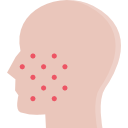
What is Acne?
In medical terms, Acne is a skin disease which chiefly concerns the oil glands that are present at the base of our hair follicles. It is most common in adolescents as the glands become active due to the stimulation received from the male hormones secreted by the adrenal glands of both the genders.
Acne are usually called pimples or ‘zits’ which are normally found on face, neck and back. The skin cells, hair clump and the oil-sebum collectively form a plug. The plug then gets infected due to the presence of bacteria which results in the swelling. In time, the plug starts to break down and a pimple develops. Many people affected by acne feel embarrassed, distressed, and under pressure about it.
There are various acne treatment options which depends on the type of acne and any underlying condition causing or affecting it. From oral medication to peels to laser acne treatments, acne requires long-term treatment and management to reduce scarring and prevent future breakouts.
What causes Acne?
According to experts, the increased production of the hormones (androgens) during the puberty is the real culprit which in turn leads to the growth of oil glands resulting in excessive sebum. The increased amount of sebum and dead skin cells therefore adds to the growth of bacteria which in turn cause an inflammatory reaction that result in red painful bumps of acne.
According to some studies, there are various other causes of Acne like genetic propensity, medication with lithium and androgen, use of greasy cosmetics or pregnancy related hormonal changes.
What are the different types of Acne pimples?
There are commonly six types of Acnes. These include:
- Open Comedones- Open comedones are small sized black or yellowish pimples that make their appearance on the skin’s surface.
- Closed Comedones- Closed comedones are firmer and are very small. They are usually present beneath the skin.
- Cysts- Cysts are large sized pus filled lesions which are clearly visible on the skin surface. They are normally painful and are prone to cause scars.
- Papules- Papules are tiny bumps typically pink or red in colour. They feel sore/tender on the skin surface.
- Pustules- Pustules can be easily identified on the skin surface. They are bumps filled with pus with a white head like tip.
- Nodules- Nodules stand out on the skin’s surface too. They happen to be bigger and painful and are often embedded in the depths of the skin.
What are the after effects of acne?
- Acne scarring
- Pigmentation
- Psychological distress
- Depression
How do we treat acne?
Our skin specialists at Dermaspace suggest the treatments depending upon the type of skin and severity of the problem. Different type of treatment includes medicines, laser treatment, peels and treatment of hormonal imbalance may require from case to case. Book your appointment today!
